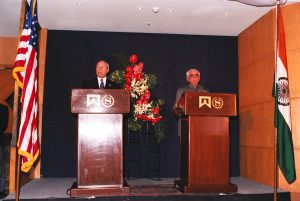Veteran Indian politician Jaswant Singh – who, during the Atal Bihari Vajpayee-led National Democratic Alliance governments, variously served as the country’s external affairs, defense, as well as finance ministers between 1996 and 2004 – died on September 27 after a prolonged illness, leaving behind a storied legacy. Present at creation – to borrow the title of former U.S. Secretary of State Dean Acheson’s memoirs – Singh’s tenure at the helm of India’s foreign ministry, as well as work as Vajpayee’s interlocutor with the U.S., was during a time India decisively renegotiated its place in the world, as a brash nuclear power realigning itself to the realities of American military unipolarity while the specter of global Islamist terrorism loomed large.
It also came at a time of significant tensions with Pakistan but also, paradoxically, possibility of peace with that country. It was, above all, during the Vajpayee era that New Delhi went back to the drawing board about India’s place in the world, shaped by incipient economic and military might — a project that continues to date with another Bharatiya Janata Party (BJP) government at the helm.
And it was in this task that Singh, a founding member of the BJP — a party not normally predisposed to thinking highly of the colonial British Raj and its representatives — found an unlikely source of inspiration –– in George Nathaniel Curzon, a former viceroy of British India between 1898 and 1905 and, later, Britain’s foreign secretary. While Curzon was and is widely reviled in India for his role in partitioning (what was then called) the Bengal Presidency in 1905, it was a lecture of Singh’s in 2002 and, subsequently, analyst C. Raja Mohan’s explication of Singh’s thinking in several articles, that the former viceroy once again became a source of inspiration for grand strategists of India.
At the heart of these efforts were two lectures by Curzon, one in 1907 in Oxford and the other, two years later, in Edinburgh. Both dwelt on the challenges of frontiers for the Raj; questions raised in both remain unresolved for contemporary India: How does one settle frontiers with recalcitrant neighboring powers, because settled they must be? What role should resolution of frontier disputes play for a country whose natural sphere of influence, by dint of maritime geography, is expansive? How should India manage its contradictory interests simultaneously?
Speaking in January 2002, Singh quoted Curzon’s 1907 lecture but added a twist: Not all frontiers, unlike Curzon’s time, are physical – some are economic, for example, but like blurred lines on maps mark overlapping sovereign equities. In fact, Singh’s contemporaneous concern was what happens when political frontiers dissolve – as they did with the European Union – marking “the beginning of the end of a phase of ‘political geography’ of the Earth,” as he put it. Remember Singh was speaking at a time when the EU seemed to be on a solid footing, old European currencies been replaced by a common Euro just earlier that month in 12 countries. Without China’s push into the western Pacific, or Russia’s into Georgia or Crimea, yet to happen borders looked “largely inviolate,” as he assumed them to be.
The view that analysts who, consequently, set out to explore the implications of Singh’s “neo-Curzonianism” was ultimately that of a sphere of soft hegemony for India in its eponymous ocean, where New Delhi aligns itself with multiple powers to develop an “India Center” (inspired by Curzon’s other, 1909, lecture). In this framework, India’s travails with Pakistan were to be managed by blunting the “razor edge” that the India-Pakistan Line of Control (LoC) in Kashmir formed which could – and did lead – to war between the two. (Remember that while Singh was delivering his lecture, the Indian military was mobilized to fight a war with Pakistan following a serious terrorist attack on the Indian Parliament the month before.) This, according to Singh and others, could be through converting the LoC into a permanent border (which’d involve both countries relinquishing claims over territory the other administers) or “softening” it to allow much greater flow of people and trade between the two and thereby making it irrelevant.
As I noted in these pages last month, by the middle of 2016 this crucial component of the neo-Curzonian vision was all but discarded, instead, for a variety of reasons, Curzon’s original emphasis on physical frontiers and borders once again rising to the fore. Since then, as India has sought to decisively tame its frontiers, “the worst it has gotten for the country in terms of expenditure of military and diplomatic efforts directed at containing the fallout of such decisions,” I wrote – a veritable paradox.
At the same the questions around protection of non-physical frontiers — of trade, economics and influence — that Singh raised in his 2002 lecture has also become increasingly prominent for New Delhi, not the least because of structural circumstances. India’s China challenge – as the Modi government now sees it – is as much a matter of protecting (or asserting) the non-physical frontier as it is defending the physical, the two being interlinked. Over the summer, as the People’s Liberation Army showed no signs of backing down in Ladakh, India has forbidden automatic flow of foreign direct investment from China, banned Chinese apps, and hinted at the exclusion of Chinese firms from 5G trials – all due to national-security concerns.
At one point in his 2002 lecture, Singh described Curzon noting that the “most urgent task of Foreign Ministers was the conclusion of frontier conventions so that sources of discord could be eliminated by an adjustment of rival interests…” How his successor – the current India External Affairs Minister, who described Singh as having influenced him the most – manages to do so, with China but also Pakistan, remains to be seen.
But Curzon lives on in India – for better or worse.

































